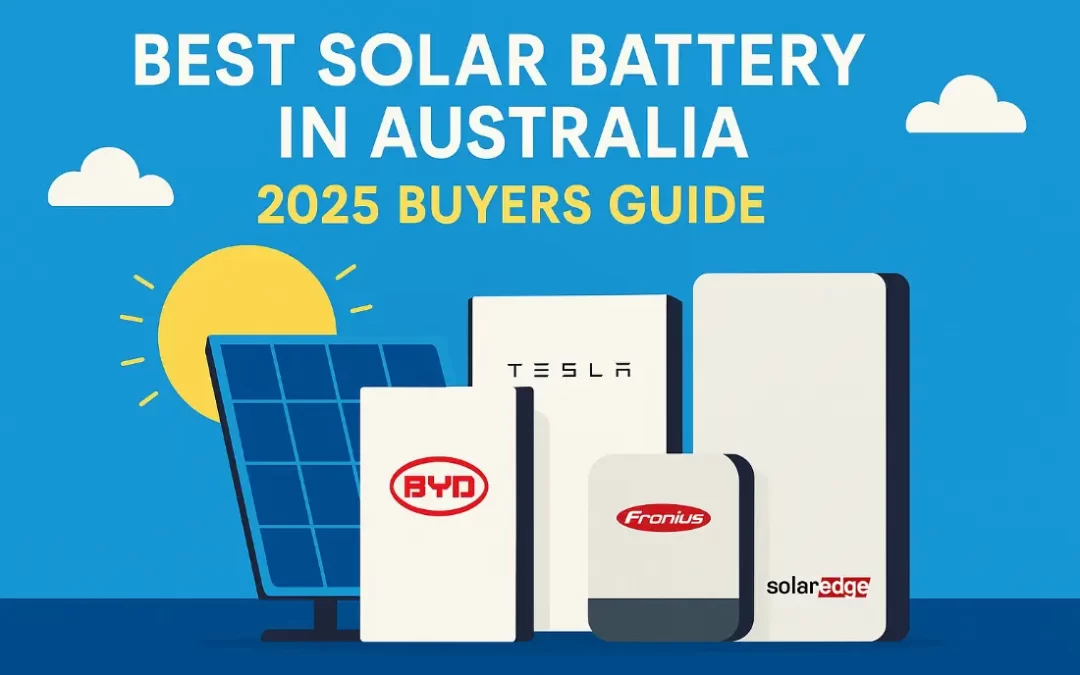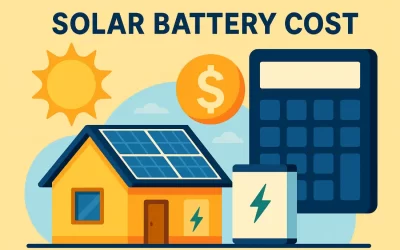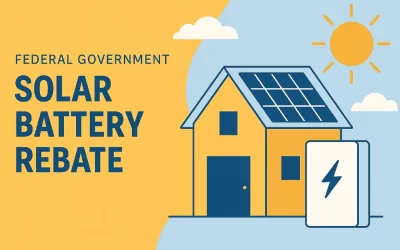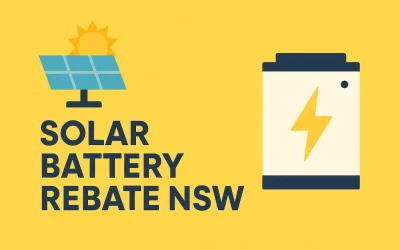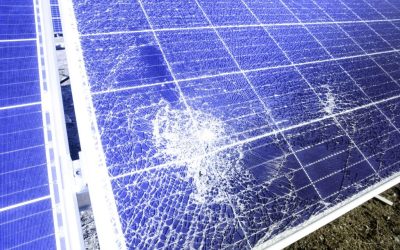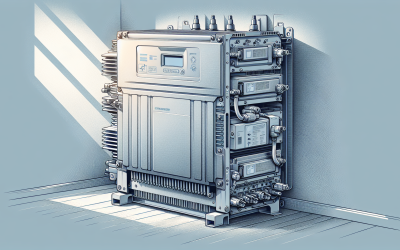Best Solar Battery Australia
It’s a sunny afternoon in Sydney and your rooftop solar panels have been hard at work all day. But as evening approaches, you might wonder – how can I use that free solar energy after dark? You’re not alone. Australia has the highest rate of rooftop solar in the world, yet according to the Australian Government, only about 1 in 40 solar-powered homes have a battery to store that energy. That means most people are still sending excess solar power back to the grid for a low feed-in tariff, then buying power at night at higher rates. Sounds familiar? With electricity bills in Sydney averaging around $2,500 a year, it’s no surprise homeowners are looking for the best solar battery to maximise their savings and energy independence.
So what’s the catch? Choosing a solar battery isn’t a one-size-fits-all deal. The “best” battery for one home might not be the best for another. Factors like your household’s energy use, budget, and existing solar setup all come into play. Plus, there are many brands and models on the market – from big names like Tesla to local favourites and budget-friendly options. Picking the wrong battery could mean spending more than you need to, or not getting the performance you expect. On the flip side, choose wisely and you’ll enjoy smaller bills, backup power in outages, and the satisfaction of using your own solar energy day and night.
Don’t worry, we’re here to help make sense of it all. In this guide, we’ll break down some of the top solar batteries available in Australia and what to consider when deciding which is right for your Sydney home. By the end, you’ll be equipped to choose the best solar battery for you.
Top Solar Battery Brands for Australian Homes
When talking about the best solar batteries in Australia, a few leading contenders always come up. Each has its own strengths – whether it’s capacity, price, or special features. Here’s a rundown of some popular options:
- Tesla Powerwall: The Tesla Powerwall is almost a household name at this point. Tesla’s battery (now on the Powerwall 3 model) offers about 13.5 kWh of usable storage and a 5 kW continuous output. It’s known for its sleek design and the robust Tesla app that lets you monitor usage easily. Many Sydney homeowners like the Powerwall for its reliable performance and backup power capability – it can keep essentials running during a blackout. The downside? It’s typically one of the more expensive batteries (think around $13,000–$15,000 installed), but you get cutting-edge tech and a 10-year warranty with guaranteed 70% capacity retention. If you want a premium, “set and forget” solution, the Powerwall is hard to beat.
- BYD Battery-Box: BYD is one of the world’s largest battery manufacturers (you might know their electric cars). The BYD Battery-Box is a modular system – you can stack units to increase capacity, making it super flexible. For instance, their Battery-Box Premium HVS series lets you start around 5 kWh and build up to 10 or even 15 kWh as needed. This modular design is great for growing families. BYD uses lithium iron phosphate (LiFePO4) chemistry, prized for safety and long cycle life. Many Aussie installers pair BYD batteries with quality inverters like Fronius or Sungrow. It’s a reliable, mid-range cost option and comes with a 10-year warranty as well.
- Alpha-ESS: A rising star, Alpha-ESS is a company with Australian presence that offers all-in-one solar battery systems. Their Alpha-ESS Smile series, for example, often includes an integrated inverter and around 10 kWh of storage. Alpha batteries have been popular in government battery programs (like in South Australia) because they tend to be more affordable than some big-name competitors while still delivering solid performance. Users report good results in terms of increasing self-sufficiency (some reaching 80–90% solar usage with a correctly sized battery). The Alpha app is basic but functional for monitoring. If you’re after value for money and support from a company that understands the Aussie market, Alpha-ESS deserves a look.
- Sungrow Battery: Sungrow is well known for their solar inverters, and they also produce affordable lithium battery systems. The Sungrow SBR series is a high-voltage stackable battery setup (often ranging roughly 9.6 kWh up to 25 kWh by adding modules). Because Sungrow makes both inverters and batteries, their systems integrate nicely – a Sungrow hybrid inverter plus SBR battery is a common combo for a cost-effective home storage solution. Performance-wise, Sungrow batteries use lithium iron phosphate cells for safety and can output decent power (often around 5 kW per stack). These batteries are often praised for being budget-friendly while still CEC-approved and reliable. If you’re looking to get a battery without breaking the bank, and especially if you already have a Sungrow inverter, this could be your best bet.
- Other Options: Other battery options include Sonnen from Germany (premium quality, long warranty), Enphase with its modular batteries (~1.2 kWh units you can stack), and new batteries by inverter brands like SolarEdge and Fronius (ideal if you already use their gear). These cater to specific needs and are worth considering too.
How to Choose the Best Solar Battery for Your Home
Now that we’ve named some of the top players, how do you actually decide which battery is your perfect match? It boils down to a few key considerations:
- Capacity and Power: Think about how much energy you want to store and use. If you have a large family home in Sydney running ducted air-con at night, you’ll need a bigger battery (10+ kWh) with a strong output (able to supply 5 kW or more) to cover your usage. On the other hand, if you’re a couple mostly concerned with evening TV, lights, and a fridge, a smaller battery (5–6 kWh) might suffice. Remember, usable capacity is what counts – some batteries reserve a bit of their capacity to extend life, so pay attention to the usable kWh. And check the battery’s power rating (kW) – that tells you how many appliances it can run at once.
- Compatibility: Not all batteries work with all solar inverters. Some batteries are “AC-coupled” with their own inverter (like Tesla Powerwall) so they can retrofit to any solar setup. Others are “DC-coupled” and might require a compatible hybrid inverter (for example, the BYD HVS works great with a Fronius GEN24 hybrid inverter). If you’re adding a battery to an existing system, you’ll either need an AC-coupled battery or to replace your inverter with one that supports your chosen DC battery. Always check with your installer about what options pair well with your current solar system.
- Warranty and Lifespan: A solar battery is a long-term investment, so you want it to last. Most quality batteries come with around a 10-year warranty. Look for details like guaranteed remaining capacity – e.g. “60% of original capacity at 10 years or at least 6,000 cycles.” This gives you a sense of how much the battery might degrade. Lithium batteries slowly lose capacity over time (just like your phone battery), but a good system should easily last 10–15 years if used properly. Also consider the manufacturer’s track record – established players like Tesla or BYD likely will be around in a decade if you ever need support or a warranty claim.
- Price and Value: Prices can vary widely. As a ballpark, expect roughly $1,000–$1,500 per kWh of storage for a fully installed system (before any rebates). That means a 10 kWh battery might cost $10,000–$15,000. The “best” battery for you isn’t necessarily the most expensive one; it’s the one that gives you the best value. Sometimes a slightly smaller or less flashy battery that meets 90% of your needs for half the price is the smarter pick. Calculate your potential savings on bills and see how the numbers stack up. And don’t forget to factor in current incentives – for example, NSW has a battery incentive program that can knock a few thousand dollars off the solar battery cost via an upfront discount.
- Installation and Service: Always use a certified, experienced installer for your battery. In fact, only licensed CEC-accredited electricians are allowed to install solar batteries in Australia – this is important for safety. A professional will ensure your battery is set up correctly with the right configuration for charging and discharging. They can also integrate it so you have backup power on critical circuits if that’s important to you. Here in Sydney, it’s a good idea to have a local solar electrician handle your battery installation – they’ll make sure the battery is installed safely, configured correctly, and compliant with regulations.
In summary, the best solar battery in Australia for you depends on your unique circumstances. Tesla might be ideal if you value brand and performance and don’t mind the price. BYD or Sungrow might be perfect if you want affordability and flexibility. Sonnen could be the choice for premium longevity, and so on. Take the time to match a battery’s specs with your household’s needs – and ask plenty of questions.
One more tip: check that any battery you choose is on the Clean Energy Council’s approved battery list. This ensures the product meets Australian safety standards. All the major brands we listed are approved, so you’re covered there.
Ultimately, installing a solar battery is about taking control of your energy – using your own daytime solar at night and keeping essentials running through blackouts. That’s the power the right solar battery can give you.
Ready to find the perfect battery for your needs? Our team at Solar Repair Sydney is here to help you compare options and install the battery that fits your home just right. Get in touch today for a quote – and take the next step toward greater energy independence and savings.

